- A stream is an
append-only sequence of tuples
- Each tuple conforms to the same
schema
- Each tuple has a time stamp
which specifies the time
that the time of origin
within the Aurora system:
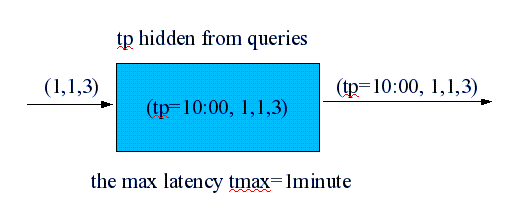
(tp = tuple timestamp)
NOTE: operator boxes "create" new tuples and these new tuples will receive a time stamp that equal to the oldest of the source tuples
Example::
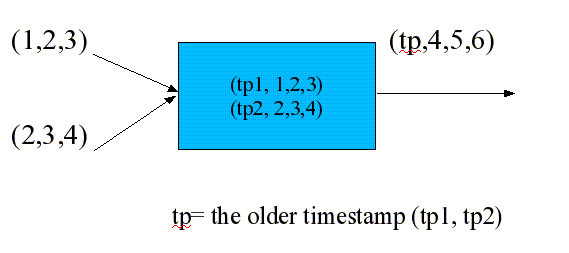
- A stream relation type has the
form:
- TS is the
time stamp of the
"stream relation type"
- A1 is the ith attribute of the "stream relation type"
-
(TS, A1,
A2, ..., An)
- TS is the
time stamp of the
"stream relation type"
- A stream tuple
has the
form:
-
(ts, v1,
v2, ..., vn)
- Often, the time stamp is omitted in the discussion, because it is rarely used
|
|
- Aurora's SQuAl has 7 operators:
- Filter
- Map
- Union
- BSort (buffered-based sort)
- Aggregate
- Join
- Resample
- The first 3 operators
(Filter, Map, Union)
are
order-agnostic
-
An order-agnostic operator
will always
produce the same output
for a stream of input - regardless of the
ordering of the tuples in the input
- The last 4 operators
(BSort, Aggregate, Join, Resample)
are
order-sensitive
-
An order-sensitive operator
will
produce different output
when the
ordering of the tuples
in the input
is changed
- The Filter operator
will output those tuples that
satisfy a given condition
- Syntax:
- Filter(P1,
P2, ..., Pm)(S)
- Pi = ith predicate
- S = the input stream
- Filter(P1,
P2, ..., Pm)(S)
- Example: "Filter(A3 >= 30)(S)"
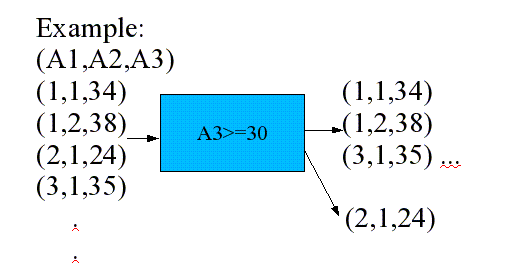
- Map is a
generalized projection operator
- Syntax:
- Map(
B1 = F1,
B2 = F2,
...
Bm = Fm)(S)
- Fi = function i (applied on the input tuples)
- Bi = name of attribute i
- S = input stream
- Map(
B1 = F1,
B2 = F2,
...
Bm = Fm)(S)
- Example: Map( B1=2*A1, B2=2*A2, B3=2*A3)
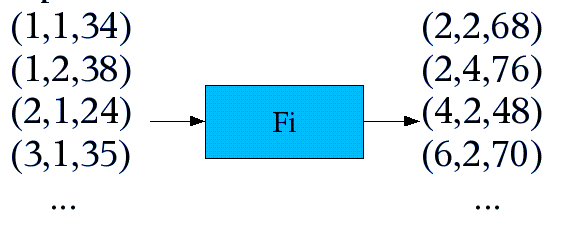
(To used the "standard" projection operation, just use the identity map)
(To remove attributes, just omit the attribute from the map operation).
- The union operation
is used to
merge 2 or more streams
into a single stream
- Syntax:
- Union(
S1,
S2,
...,
Sm)
- Si = input stream i
- NOTE: the value of the time stamp of the output tuple is equal to the time stamp of the input tuple
- Union(
S1,
S2,
...,
Sm)
- Example: Union(S1, S2)

- The other operators in
SQuAl are
order-sensitive
- Order-sensitive operators can only be guaranteed to execute using finite buffer space and finite time if the operators can assume some ordering over their input streams
- In SQuAl,
you can specify an order
on a stream.
- Out of order:
- A tuple, t in stream S, is out of order by n with respect to attribute A in stream S if there are more than n tuples, u, preceding t in stream S such that u.A > t.A
Example:
- 1, 3, 1,
2, 4, 4, 8, 3, 4, 4
- 1 is out of order by
1
- (the value 3 preceeds it)
- 3 is out of order by
3
- (the values 4, 4 and 8 preceed it)
- 4 is out of order by
1
- (the value 8 preceeds it)
- 4 is out of order by 1 - (the value 8 preceeds it)
- 1 is out of order by
1
- (the value 3 preceeds it)
- An order specification
in Aurora has the following form:
- A:
attribute values of this attribute will be
ascending
- n is a
non-negative value
This is the number of out of order tuples that will be tolerated
This parameter will reserve n + 1 buffer entries to process the flow.
(See an example later)
- Bi:
grouping attribute i
The input tuples are partitioned according to the GroupBy attributes.
The order of the tuples in each partition is considered independently (from other partitions)
-
Order( On A,
Slack n,
GroupBy B1,
B1, ...
Bm )
- A:
attribute values of this attribute will be
ascending
- Effect of the order specification:
A order specification works like a filter:
- An arriving tuple that
conforms to the order specification
is allowed to pass through
- An arriving tuple that
violates
to the order specification
is discarded
This is according to the paper (page 12):

- An arriving tuple that
conforms to the order specification
is allowed to pass through
- Example: Order(On A, Slack 2, GroupBy NULL)
Time: | 1 | 2 | 3 | 4 | 5 | 6 | 7 | 8 | 9 | 10| --+---+---+---+---+---+---+---+---+---+---+--------- sample --+---+---+---+---+---+---+---+---+---+---+--------- input stream: | 1 | 3 | 1 | 2 | 4 | 4 | 8 | 3 | 4 | 4 | --+---+---+---+---+---+---+---+---+---+---+--------- Buffer content: --+---+---+---+---+---+---+---+---+---+---+-------- | 1 | 1 | 1 | 1 | 2 | 3 | 4 | 4 | 4 | 4 | --+---+---+---+---+---+---+---+---+---+---+-------- | - | 3 | 1 | 2 | 3 | 4 | 4 | 4 | 4 | 4 | --+---+---+---+---+---+---+---+---+---+---+-------- | - | - | 3 | 3 | 4 | 4 | 8 | 8 | 8 | 8 --+---+---+---+---+---+---+---+---+---+---+-------- | V 3 violates order specification Discarded ?? (page 131, line 6) Output stream: (= first item in buffer) --+---+---+---+---+---+---+---+---+---+---+-------- | - | - | 1 | 1 | 2 | 3 | 4 | 3 | 4 | 4 | --+---+---+---+---+---+---+---+---+---+---+--------NOTE: GroupBy NULL means use no grouping attributes
It will put all tuples in the same group
- Example: Order(On A, Slack 0,
GroupBy NULL)
- When slack = 0, then the tuples in a stream are expected to arrive in (ascending) order
- The BSort
operator is an
approximate sort operator
- Syntax:
- BSort( Assuming O ) (S)
- O is an
order specification
(see above)
- S is the input stream
- O is an
order specification
(see above)
- BSort( Assuming O ) (S)
- Example:
O = Order( On A , Slack 2 , GroupBy NULL ); BSort( O ) (S)Input stream: 1, 3, 1, 2, 4, 4, 8, 3, 4, 4
Output:
Time: | 1 | 2 | 3 | 4 | 5 | 6 | 7 | 8 | 9 | 10| --+---+---+---+---+---+---+---+---+---+---+--------- sample --+---+---+---+---+---+---+---+---+---+---+--------- input stream: | 1 | 3 | 1 | 2 | 4 | 4 | 8 | 3 | 4 | 4 | --+---+---+---+---+---+---+---+---+---+---+--------- Buffer content: --+---+---+---+---+---+---+---+---+---+---+-------- | 1 | 1 | 1 | 1 | 2 | 3 | 4 | 4 | 4 | 4 | --+---+---+---+---+---+---+---+---+---+---+-------- | - | 3 | 1 | 2 | 3 | 4 | 4 | 4 | 4 | 4 | --+---+---+---+---+---+---+---+---+---+---+-------- | - | - | 3 | 3 | 4 | 4 | 8 | 8 | 8 | 8 | --+---+---+---+---+---+---+---+---+---+---+-------- | V 3 violates order specification It's not discarded ???????? (Contradicts page 131, line 6) Output stream: (= first item in buffer) --+---+---+---+---+---+---+---+---+---+---+-------- | - | - | 1 | 1 | 2 | 3 | 4 | 3 | 4 | 4 | --+---+---+---+---+---+---+---+---+---+---+--------
I think there is an error - according to the definition of Order, the system should discard the value 3 that is 3 places out of order...
Then again, it could be that the BSort operator never discard tuples but output out of order tuples as soon as possible..
I did not write the paper; so I can't tell you if this is a real error. Here is the actual example in the paper:

- The Aggregate
operator applies a
(window) function
on a window of tuples
in the input stream
- Window:
- A window is a
subsequence of tuples
in the input stream
- Example:
Input stream: 1 4 5 8 3 1 3 4 6 ... | | +-------------+ "window"
- A window is a
subsequence of tuples
in the input stream
- Syntax:
- Aggregate(
F,
Assuming 0,
Size s,
Advance i) (S)
- F: function
- O: the
ordering
on the input stream
- s = size of the window
(number of elements used in the function)
- i: an integer
or a predicate that
specify how
(far) to advance (silde) the window
- S = input stream
- F: function
- Output format:
the output format of
Aggregate is
similar to a
Group BY query in
SQL
The output format consists of the grouping attributes and the aggregate function value
- The time stamp of the output tuple is equal to the smallest time stamp in the window of tuples
- Aggregate(
F,
Assuming 0,
Size s,
Advance i) (S)
- Example: tracking average hourly prices of stocks
-
Input stream schema: (Sid, Time, Price)
- Sid = stock ID
- Time = time that the stock price is valid
- Price = price of the stock at that time
SQuAl aggregate function:
- Tuples are first
partitioned
by Sid and
ordered
according to
Time
- Then each substream is
sampled for
1 hour (Size 1hour)
The function Average is applied to the tuples in this window (per group)
- After each sample the window is advanced to the next hour (Advance 1hour)
-
Aggregate( Avg(Price),
Assuming Order(On Time, GroupBy Sid),
Size 1hour,
Advance 1hour)
Sample input data:
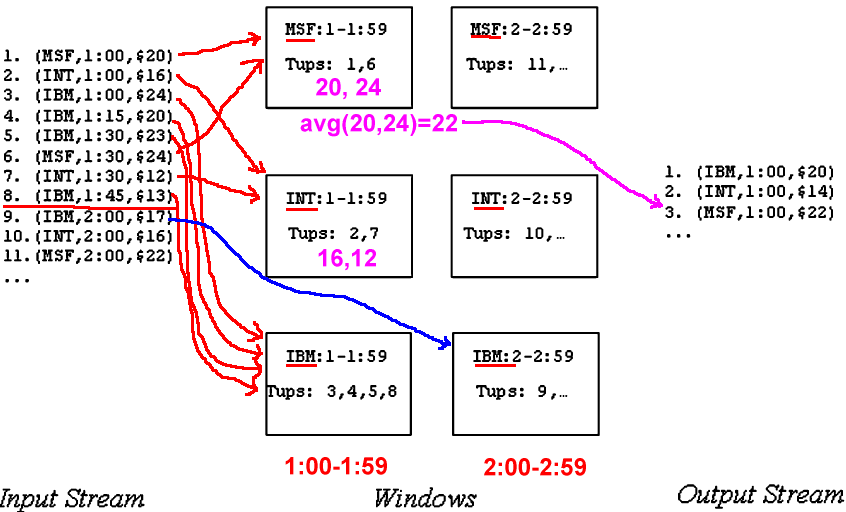
- The Join operator is
a binary (using 2 streams) operation
that joins tuples in 2 streams with each other.
The Join operation is apply on windows of tuples
(Ideally you would wait for a streams to drain completely before performing the join operation... but that is not possible with stream queries).
- Syntax:
- Join( Predicate, Size s, Left Assuming O1, Right Assuming O1) (S1, S2)
- Predicate:
the join condition
- O1 is
an ordering on the
input stream
S1
- O2 is
an ordering on the
input stream
S2
- Size s is a
"size constraint" on
the difference in ordering:
- Let u
be a tuple in
S1
that satisfies the ordering
O1
And assume the ordering O1 is on the attribute A in S1
- Let v
be a tuple in
S2
that satisfies the ordering
O2
And assume the ordering O2 is on the attribute B in S2
- The size constraint
Size s
requires that the tuples must
satisfy:
-
| u.A - v.B | < s
- Let u
be a tuple in
S1
that satisfies the ordering
O1
- Example: find soldiers occupying the same position
within 10 minutes of each other
-
Input stream schema:
(Sid, Time, Position)
- Sid = soldier's ID
- Time = time of the position report
- Position = position of the soldier at the given time
Join predicate: S1.Position = S2.Position
Sample input data:


In addition to the predicate S1.Position = S2.Position, the tuple must also satisfy:
-
| S1.Time - S2.Time | < 10 min
- The Resample operation is
like a join operation
using a
generalized window join condition
A set function (window function) is applied on the matching set of tuples to produce a single tuple
- Syntax:
- Resample( F, Size s, Left Assuming O1, Right Assuming O2) (S1, S2)
- F: the
window function that
is applied in the
matching set of tuples
(How the tuples are matched is discussed next)
- O1 is
the ordering on some
attribute S1.A
in input stream
S1
- O2 is
the ordering on some
attribute S2.B
in input stream
S2
- Size s is again a
"size constraint" on
the difference in ordering:
- Let u
be a tuple in
S1
that satisfies the ordering
O1
And assume the ordering O1 is on the attribute A in S1
- Let v
be a tuple in
S2
that satisfies the ordering
O2
And assume the ordering O2 is on the attribute B in S2
- The size constraint
Size s
requires that the tuples must
satisfy:
-
| u.A - v.B | < s
- Let u
be a tuple in
S1
that satisfies the ordering
O1
- The output of
Resample is
driven by the
data in the input stream S1
For each tuple in S1, the aggregate (set) function F is applied on the tuples in stream S2 that satisfy:
-
| u.A - v.B | < s
- Example on using Resample:
- Given a stream of data on the
location of platoons
- The format of the data stream is: (ID, Time, X-Location)
Query:
- Find the approximate location of a platoon at certain time (e.g., 2:00, 2:15, 2:30, etc...)
- Given a stream of data on the
location of platoons
- Solution:
- Generate an artificial heart beat
time stream
E.g.: 2:00, 2:15, 2:30, etc....
- Resample the
location data stream
driven by the
heart beat stream:
- S1 = heart beat stream
- O1 =
Order(On S1.Time)
- Ss = location data stream
- O1 =
Order(On S2.Time)
- Size s = pick...
10 min
- F: avg(S2.X-Location)
- Generate an artificial heart beat
time stream
- Example worked out with sample input data:
- Example:
- to compute the 3rd item (1, 2.15, 2.33), the Resample operation uses tuple Heartbeat (2:15)
- then look for all tuples in the location stream on Platoon 1 that are within 10 min from the given time.
- There are 3 tuples: (1, 2:08, 3), (1, 2:12, 1), (1, 2:21, 3)
- The average of the location value is: (3 + 1 + 3)/3 = 2.33
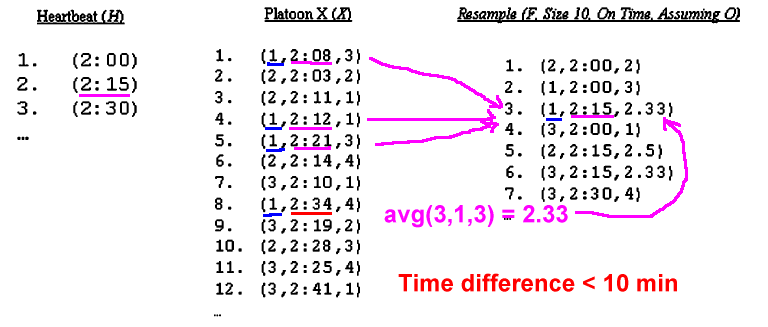
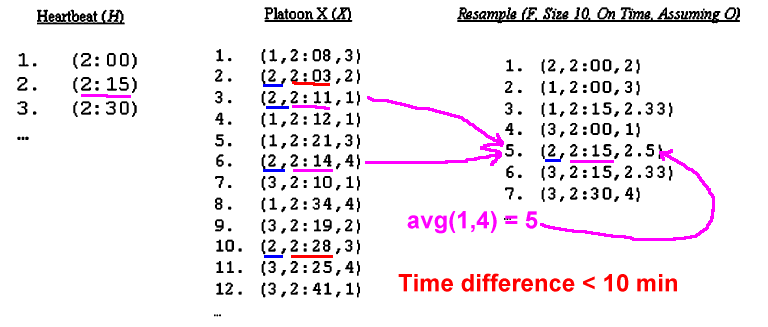
- Example:
- Data stream:
- (ID, Time, Position)
The data represents the position of a soldier ID at a given time Time
- Query:
- Find the times that m or more soldier pass a certain border at the same time
- Sample input stream processing:
- Find the times that 3 or more soldier pass a certain position 30 at the same time
Concrete data:

- SQuAl query:
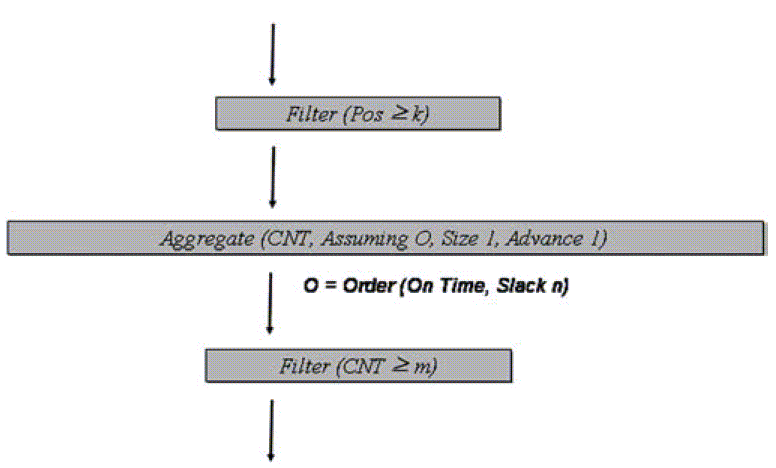
- Users use an
GUI interface to
define operator (boxes) and
make the connections between the operators:
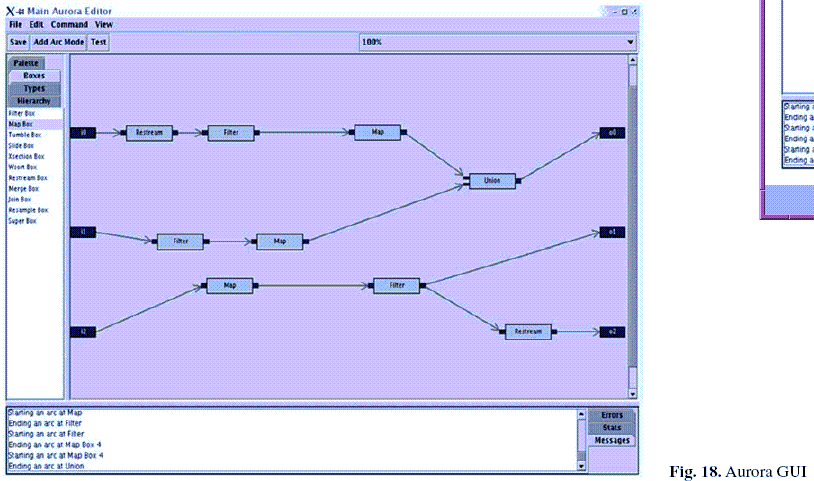
- The GUI has a
queue monitor tool
that allows the user to observe
the content of the queues:
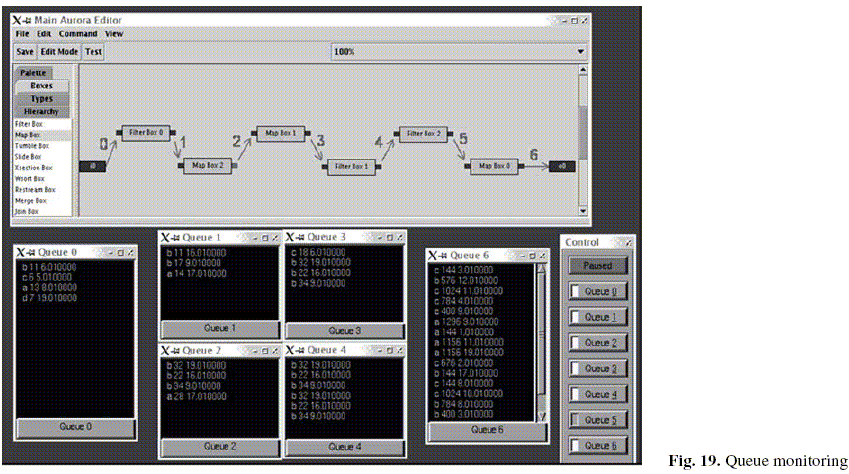
That can be a helpful tool in debugging